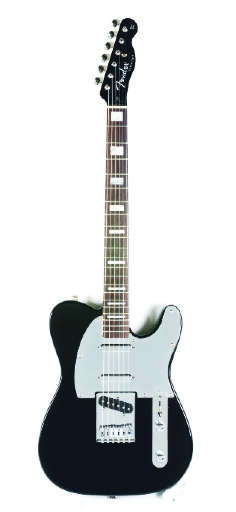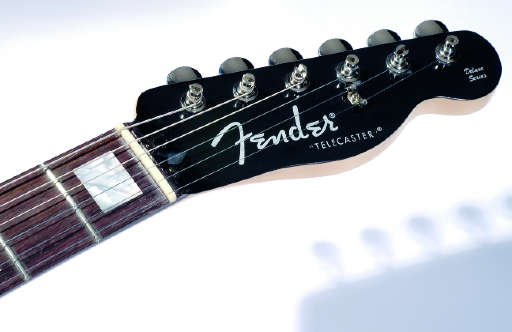MusicRadar Verdict
The Big Block Telecaster promises a great deal, but our impression of the model has been rather soured by production inconsistencies on this particular instrument.
Pros
- +
Covers some Strat territory too.
Cons
- -
Nut and scratchplate poorly cut.
MusicRadar's got your back

This Tele can also sound like a Strat!

The headstock boasts vintage-style machine heads.
Block inlays may not be the first cosmetic feature that springs to mind when one thinks of Fender, but they are certainly not unprecedented in the company's catalogue.
Although undoubtedly a guitar that polarises opinion in the same fashion as Marmite, we honestly can't think of anything cooler than a late sixties Jazzmaster with block inlays in Lake Placid Blue.
Bang up to date though, one of Fender's latest variations on a theme includes the new Big Block series Telecaster. It certainly isn't the first time that Fender has taken one of its most iconic guitar designs and made some cosmetic and sonic modifications, and initially the Big Blocks echo the moody black aesthetic of the Aerodyne series (see issue 249 for a full review), as well as the Iron Maiden and John 5 Signature Fenders.
Overview
Along with block-inlaid fretboards, the Big Block instrument features striking chrome mirror scratchplates, complemented by chrome dome knobs and even chrome-tipped pickup selector switches.
The black and chrome combination with matching painted headstocks works effectively on the Tele, despite the increased susceptibility to fingerprints and smears. Some players may feel that the guitar looks a little too 'metal', but equally, those of you who think that a standard Tele looks rather weedy next to more out and out rock machines might be won over by the more rock aesthetic.
When subjecting the Telecaster to closer scrutiny, it is apparent that the pickguard hasn't been cut particularly well and the horn section is rather elongated. Rather than maintaining a parallel line between the edge of plate and body, the plate edge extends slightly over the rounded edge of the body itself.
This is really only a cosmetic issue that has no impact on the guitar's playability around those upper frets, but ultimately it suggests an uncharacteristic lack of attention to detail and quality control at the Mexican factory. Hopefully other examples of the model won't feature this kind of sloppiness.
In other aspects, construction standards are largely high. The block inlays themselves have been neatly installed on the Telecaster's fretboards with minimal visible filler, while the 21 medium jumbo frets themselves are also tidy and free from any protruding sharp ends.
When we pick the Tele up and play a few licks, it's noticeable that the nut slots have been cut rather too shallow and the resulting clearance of the strings over the first fret contributes to a needlessly high action.
It is the first example of this we've seen on a Fender of any origin in a while, but the bottom line is that if you are paying £699 for a guitar, having to fork out immediately for work on the nut is an unwelcome surprise.
Down at the other end of the strings, the Tele's six-saddle straight-through-body bridge is about as solid as hardtails come. At the headstock end, the strings are anchored by vintage-style machine heads rather than the modern standard units specified - in truth a more elegant solution that in both cases looks much smarter in combination with the painted headstock fascias and fifties-style 'spaghetti' Fender logo decal.
When it comes to its electronics, the guitar is a clear departure from standard Telecaster configurations. The trio of single-coils are switched in precisely the same way as a standard Stratocaster - the reverse wound, reverse polarity middle pickup ensures hum-cancelling with the twin pickup mixes at positions two and four.
Some Telecaster fans may lament the addition of a middle pickup as needlessly complicating a timeless design, but for players who want the look and vibe of a Telecaster with the extra sonic options of a Strat this is the happiest compromise.
The trade-off for the extra Strat-a-like sounds is that there's no access to the traditional bridge and neck combination that the middle position of a Telecaster three-way selector would usually give; a shame as this is typically a great voice for expansive rhythm playing and luxuriant arpeggios.
Sounds
The Tele's bridge unit sound is initially thin and reedy but upping the amp level a little and adjusting the equalisation to taste helps coax the pickup out of its shell and, lo and behold, a strident voice emerges that is great for raw electric slide playing - further facilitated by the guitar's rather high action - and scything chords alike.
Backing off to a smidgen of grit, the unadorned bridge pickup is pure sixties power-pop, albeit with a voice that is a little more generic than some.
The three-pickup 'in-between' positions provide some distinctly Fender voices that, with a cleaner amplifier sound, are deliciously glassy and imbued with a resonant musicality.
The neck pickup is, as ever, a hugely underrated voice, while the middle pickup alone is useful for lead parts that require a little more bite and assertiveness than the classic two-pickup Tele middle setting provides.
Due in part to its rosewood fretboard, the Big Block Series Telecaster isn't as naturally tonally brittle as all-maple necked Fenders can be, so it doesn't get too shrill unless you sculpt the EQ as such.
Chris Vinnicombe worked with us here on the MusicRadar team from the site's initial launch way back in 2007, and also contributed to Guitarist magazine as Features Editor until 2014, as well as Total Guitar magazine, amongst others. These days he can be found at Gibson Guitars, where he is editor-in-chief.
“The most musical, unique and dynamic distortion effects I’ve ever used”: Linkin Park reveal the secret weapon behind their From Zero guitar tone – and it was designed by former Poison guitarist Blues Saraceno’s dad
Arturia’s V Collection gets a Roland JP-8000 emulation and lo-fi synth/sampler, along with five more instruments and a host of updates
Capture the sound of The Last of Us season 2's haunting soundtrack with Spitfire Audio’s latest software instrument, Ronroco by Gustavo Santaolalla









